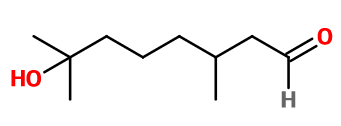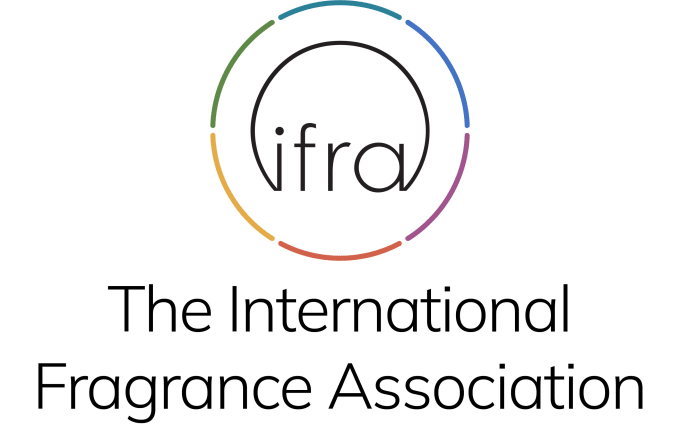
Photo credits: ScenTree SAS
Hydroxycitronellal
Laurinal® ; Cyclosia® ; Cyclosia Base® ; 7-hydroxy-3,7-dimethyloctanal ; Citronellal hydrate ; Citronellaldehyde ; Oxydihydrocitronellal ; Hidroxycitronellal ; 7-hydroxy-3,7-dimethyloctanal ; Lily aldehyde ; Muguet synthetic ; Muguettine principle ; Oxdihydrocitronellal

Photo credits: ScenTree SAS
| Company | Ingredient Name | ID | Comments | Naturality | Certifications | Purity | Latin name | Treated part | Geographical origin | MOQ |
|---|---|---|---|---|---|---|---|---|---|---|
|
|
Hydroxycitronnellal - 30 Gr | - |
Visit website
|
- | - | - | - | - | - | |
|
|
Hydroxycitronellal | 30035054 |
Visit website
|
Molecule | - | - | - | - | - | |
|
|
Hydroxycitronellal BMBcert™ | 30786644 |
Visit website
|
Molecule | - | - | - | - | - |
General Presentation
-
CAS N° : 107-75-5
-
EINECS number : 203-518-7
-
FEMA number : 2583
-
FLAVIS number : 05.012
-
JECFA number : 611
-
Appearance : Colorless liquid
-
Density : 0,942
-
Volatility : Heart
-
Price Range : €€
Physico-chemical properties
-
Molecular formula : C10H20O2
-
Molecular Weight : 172,27 g/mol
-
Log P : 1,42
-
Fusion Point : Donnée indisponible.
-
Boiling Point : 257°C
-
Detection Threshold : Donnée indisponible.
-
Optical rotation : Donnée indisponible
-
Vapor pressure : Donnée indisponible
-
Refractive Index @20°C : Donnée indisponible
-
Acid Value : Donnée indisponible.
-
Flash Point : 113°C
Uses
Uses in perfumery :
Hydroxycitronellal is used in white flowers notes: lily of the valley, lilac. Tends to be more and more restricted.
Year of discovery :
Discovered in 1905.
Natural availability :
Hydroxycitronellal is not available in its natural state.
Isomerism :
Hydroxycitronellal has an asymmetric carbon that gives rise to two possible enantiomers with a similar smell. Florol® is a constitutional isomer of Hydroxycitronellal. Both are used in particular in lily of the valley reconstructions. However, Florol® tends to replace Hydroxycitronellal in formulas, as it is not regulated.
Synthesis precursor :
Hydroxycitronellal is a precursor molecule of the synthesis of Aurantiol (Schiff Base), by reaction with Methyl Anthranilate .
Synthesis route :
Hydroxycitronellal can be synthesized from several different reagents. The final product can be obtained from Citronellal in an acid medium and by reaction with sodium carbonate. From Citronellol, an acid hydrolysis reaction in the presence of sulfuric acid allows to obtain a diol, capable of undergoing a dehydrogenation catalysed by copper and zinc, for example. This method offers a high purity and a very good yield. From Myrcene, a reaction with a dialkylamine allows to synthesize 7-hydroxygeranyl dialkylamine, after an acid hydrolysis. After that, the presence of palladium (II) phosphine in a catalytic amount allows to change the place of the double bond in order to obtain a compound called enamine. A last acid hydrolysis of this compound allows to obtain Hydroxycitronellal.
Regulations & IFRA
Allergens :
This ingredient does not contain any allergen.
IFRA 51th :
This ingredient is restricted by the 51th amendment
- Quantitative limit on the use :
-
Cat.1 Cat.2 Cat.3 Cat.4 Cat.5A B C DCat.6 0,38 % 0,11 % 2,3 % 2,1 % 0,53 % 0,53 % 0,53 % 0,18 %1,2 % Cat.5A B C DCat.6 0,53 % 0,53 % 0,53 % 0,18 %1,2 % Cat.7A BCat.8 Cat.9 Cat.10A BCat.11A BCat.12 1,6 % 1,6 %0,18 % 4,1 % 0,78 % 7,8 %0,18 % 0,18 %No restriction Cat.10A BCat.11A BCat.12 0,78 % 7,8 %0,18 % 0,18 %No restriction


